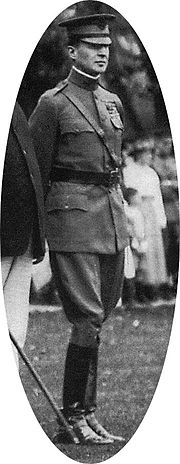The MacArthur Reforms and Wartime Mobilization
The U.S. Army entered World War I desperately short of junior officers. To fill the void, the Academy adopted a three-year, abbreviated schedule that graduated cadets as quickly as possible. Basic training in infantry skills and small unit leadership was accelerated. Many academic courses were shortened or dropped entirely to make room in the curriculum. The Academy also began offering flight instruction to cadets. It hoped to construct its own fixed-wing airfield, but budget constraints always prevented it. War’s end created an awkward situation for the Academy—many of those who had attended accelerated classes could benefit from additional coursework, but few graduates were eager to return to West Point. The Army resolved the issue by returning these individuals to the Academy to finish their education but allowing them to retain their officer status.
Gen. Douglas MacArthur became the first postwar superintendent in 1919. Just 39 years old, he was eager to leave his mark. MacArthur embarked upon a series of curriculum reforms, many of which were opposed by the Academic Board, which consisted of the school’s senior military professors. In MacArthur’s opinion, the curriculum had focused so much on mathematics that the Academy had fallen behind other civilian engineering schools. Limited changes were made during his tenure, but West Point returned to its rote curriculum after he left office. MacArthur also fought to expand the Academy’s size from roughly 1,500 to 2,400 cadets, to better keep pace with Army’s expansion.
West Point faced an even greater mobilization crisis during World War II and again adopted the three-year, accelerated program. Compounding these problems, the War Department approved a plan that allowed up to 60 percent of any graduating class to accept commissions in the Army Air Corps, which left traditional combat branches, such as the infantry, armor, and artillery, even more shorthanded in terms of their complement of Academy graduates. The Academy was also left drastically short of instructors. Typically, its faculty was made up of graduates at the rank of captain or major, but in wartime the operational forces had the greater need for these officers. As a result, the Academy turned to reserve and officers who were not graduates to fill its faculty. Many of these wartime practices would prove to be the springboard for permanent reforms to the academic program in the postwar era.
